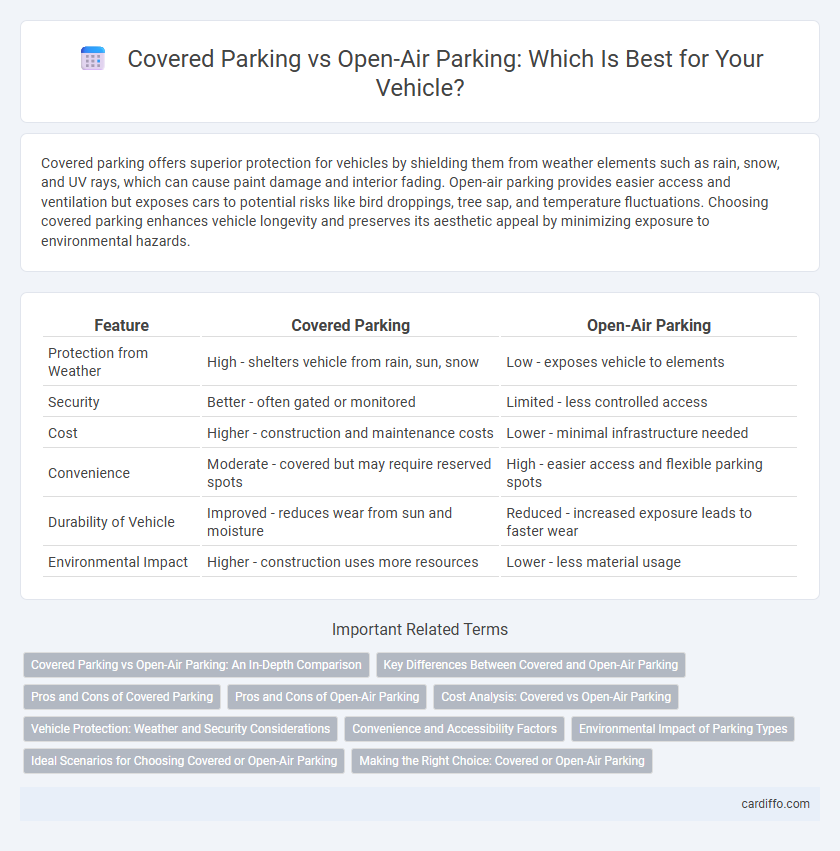Covered parking offers superior protection for vehicles by shielding them from weather elements such as rain, snow, and UV rays, which can cause paint damage and interior fading. Open-air parking provides easier access and ventilation but exposes cars to potential risks like bird droppings, tree sap, and temperature fluctuations. Choosing covered parking enhances vehicle longevity and preserves its aesthetic appeal by minimizing exposure to environmental hazards.
Table of Comparison
| Feature | Covered Parking | Open-Air Parking |
|---|---|---|
| Protection from Weather | High - shelters vehicle from rain, sun, snow | Low - exposes vehicle to elements |
| Security | Better - often gated or monitored | Limited - less controlled access |
| Cost | Higher - construction and maintenance costs | Lower - minimal infrastructure needed |
| Convenience | Moderate - covered but may require reserved spots | High - easier access and flexible parking spots |
| Durability of Vehicle | Improved - reduces wear from sun and moisture | Reduced - increased exposure leads to faster wear |
| Environmental Impact | Higher - construction uses more resources | Lower - less material usage |
Covered Parking vs Open-Air Parking: An In-Depth Comparison
Covered parking offers superior protection against weather elements such as rain, snow, and UV rays, significantly reducing vehicle damage and maintenance costs. In contrast, open-air parking exposes vehicles to environmental hazards, accelerating wear and tear while often lacking security features. Choosing covered parking enhances vehicle longevity and safety, making it a cost-effective option despite higher initial expenses compared to open-air alternatives.
Key Differences Between Covered and Open-Air Parking
Covered parking offers protection from weather elements such as rain, snow, and UV rays, reducing damage to vehicles and prolonging their lifespan. Open-air parking, while typically more affordable and easier to access, exposes cars to environmental risks and potential dirt accumulation. Security features are often enhanced in covered parking through controlled access and surveillance, unlike open-air lots where monitoring may be limited.
Pros and Cons of Covered Parking
Covered parking offers protection from weather elements such as rain, snow, and sun, reducing vehicle damage and maintaining car appearance. It enhances security by limiting exposure to theft and vandalism compared to open-air parking. However, covered parking typically comes at a higher cost and may have limited availability in crowded urban areas.
Pros and Cons of Open-Air Parking
Open-air parking offers advantages such as lower cost and easier accessibility compared to covered parking, enabling quick vehicle entry and exit without structural restrictions. However, vehicles parked in open-air spaces are exposed to weather elements like rain, sun, and snow, which can lead to faster wear and potential damage. Security concerns are heightened due to lack of physical barriers, increasing the risk of theft and vandalism in open-air parking lots.
Cost Analysis: Covered vs Open-Air Parking
Covered parking typically incurs higher initial construction and maintenance costs due to materials, structural support, and weatherproofing requirements compared to open-air parking, which relies mainly on paving and minimal infrastructure. Operating expenses for covered parking include lighting, ventilation, and security systems, whereas open-air lots generally require less energy consumption and simpler upkeep. Long-term cost benefits of covered parking may arise from vehicle protection against elements, potentially reducing insurance claims and enhancing property value.
Vehicle Protection: Weather and Security Considerations
Covered parking provides superior protection against weather elements such as rain, snow, hail, and UV rays, significantly reducing the risk of paint damage and interior fading. It also enhances security by limiting exposure to theft and vandalism through physical barriers or controlled access. Open-air parking, while more accessible and cost-effective, exposes vehicles to environmental hazards and a higher risk of opportunistic crimes.
Convenience and Accessibility Factors
Covered parking offers enhanced convenience by protecting vehicles from weather elements like rain, snow, and UV rays, ensuring easier access without exposure to harsh conditions. Open-air parking provides greater accessibility with typically more spaces available, allowing for quicker entry and exit without the need for ramps or elevators. Location of covered parking structures near building entrances often combines protection with accessibility, optimizing user experience.
Environmental Impact of Parking Types
Covered parking structures help reduce the urban heat island effect by providing shade and lowering surface temperatures compared to open-air parking lots, which absorb and radiate more heat due to exposed pavement. The construction of covered parking often involves materials with higher embodied carbon, but it offers potential for energy savings when integrated with solar panels or green roofs. Open-air parking tends to increase stormwater runoff and pollution risks, whereas covered parking can incorporate systems to manage and mitigate environmental impacts more effectively.
Ideal Scenarios for Choosing Covered or Open-Air Parking
Covered parking suits urban areas with harsh weather conditions, protecting vehicles from rain, snow, and sun damage, while enhancing security and reducing maintenance costs. Open-air parking is ideal for locations with mild climates, lower budget constraints, and short-term parking needs where natural ventilation and easy access are priorities. Businesses with frequent vehicle turnover or scenic destinations benefit from open-air lots, whereas residential complexes and office buildings typically prefer covered parking for long-term vehicle protection.
Making the Right Choice: Covered or Open-Air Parking
Covered parking offers protection from weather elements such as rain, snow, and sun, reducing vehicle wear and enhancing security against theft or vandalism. Open-air parking provides cost-effective and flexible options, ideal for short-term use or locations with mild climates. Choosing between covered and open-air parking depends on factors like budget, vehicle protection needs, regional weather conditions, and duration of parking.
Covered parking vs Open-air parking Infographic

 cardiffo.com
cardiffo.com